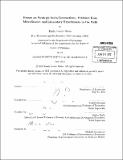Essays on strategic social interactions : evidence from microfinance and laboratory experiments in the field
Author(s)
Breza, Emily Louise
DownloadFull printable version (11.05Mb)
Other Contributors
Massachusetts Institute of Technology. Dept. of Economics.
Advisor
Abhijit Banerjee and Esther Duflo.
Terms of use
Metadata
Show full item recordAbstract
This thesis investigates the role of strategic social interactions in household decision-making using empirical evidence from India. In the first chapter, I ask how the actions of peers influence an individual's own decision to repay her loan obligations. In the subsequent chapters, I employ experiments to unpack some of the complex social interactions at play in communities in India. In each chapter, the value of social relationships plays a key role in influencing behavior. Chapter 1 examines peer effects in the case of microfinance. Around the world, microfinance institutions (MFIs) have invested heavily in building social capital and generally boast stellar repayment rates. However, recent repayment crises have fueled speculation that peer effects might also reinforce default behavior. I estimate the causal effect of peer repayment on individuals' repayment decisions in the absence of joint liability following a district-level default in which 100% of borrowers temporarily defaulted on their loans and after which borrowers gradually decided whether to repay. Because the defaults occurred simultaneously, the timing of the shock induced variation in repayment incentives both at the individual and peer group levels. Individuals (or peer groups) near the end of their 50-week loan cycles were closest to receiving new loans and had the strongest incentives to repay; those who had recently received disbursements had the weakest. Using the variation in the peer group's incentives to instrument for peer repayment, I find that if a borrower's peers shift from full default to full repayment, she is 10-15pp more likely to repay. Last, I present a dynamic discrete choice model of the repayment decision to estimate the net benefit of the peer mechanism to the MFI. Repayers' positive influence on others (not non-repayers' negative influence) mainly drives the effect. Thus, peer effects actually improve repayment rates relative to a counterfactual without peer effects. The second chapter (co-authored with my classmates Arun Chandrasekhar and Horacio Larreguy) uses detailed network data to study the role social interactions may play in contract enforcement and in determining the scope of co-investment. We perform laboratory experiments in Indian villages with non-anonymous participants, where participants play basic two-party trust games with a sender and receiver. In some treatments, we introduce third-party monitors or punishers that may or may not be identifiable by the other two participants. We find that the social network interacts with the play of the game in economically meaningful ways. First, social proximity partially mitigates the investment problem. Second, very central punishers are efficiency enhancing. Third, elites benefit from higher partner transfers, but do not use their status to increase total surplus. Finally, we use our results to provide an assessment of institutional structures as a function of network shape. Typically, socially far judges encourage efficient behavior, while socially close judges are prone to collusion. The final chapter (co-authored with Arun Chandrasekhar) explores the diffusion of information about rival goods. We randomly invite households to come to a pre-specified, central location in 39 villages to participate in laboratory games. Because many households that were not directly invited turned up at our experiments, we study how the information about the opportunity to earn close to one day's wage diffuses through rural Indian communities. Furthermore, because some members of some of the villages had prior experience playing similar laboratory games, we ask how experience with a task affects information-spreading and -seeking behavior. Finally, we examine possible channels for strategic information diffusion. In our environment, participant slots for non-invited households are limited, making them rival goods. Additionally, participants could potentially receive larger payoffs from playing the laboratory games with their peers. Because of these two motivations, we examine how final participation patterns may reflect strategic behavior on the part of informed households.
Description
Thesis (Ph. D.)--Massachusetts Institute of Technology, Dept. of Economics, 2012. Cataloged from PDF version of thesis. Includes bibliographical references (p. 129-133).
Date issued
2012Department
Massachusetts Institute of Technology. Department of EconomicsPublisher
Massachusetts Institute of Technology
Keywords
Economics.